
Wuchang: Fallen Feathers Review
The first announcement of Wuchang: Fallen Feathers was quite peculiar at the time. Back during its initial reveal in September 2021, Chengdu-based Leenzee game studio decided to announce its first project through a lengthy 18-minute gameplay trailer. It already looked relatively polished at the time, but they immediately shared that they planned to continue working on Wuchang: Fallen Feathers for the next three years.
It wasn’t until June 2024 that Leenzee’s Chinese action RPG re-emerged into the public spotlight. While the Black Myth: Wukong colossus had yet to release, I have to imagine the overwhelming success that Game Science experienced caused a rippling effect on Leenzee with a clear message - there was a gigantic appetite for Chinese developers in the premium, non-mobile focused game market.
Of course, the Soulslike sub-genre in the action RPG space continues to be as prevalent as ever; I’m personally not against it, and am always curious to see how developers, new and old, tackle their spin on it. I think what fascinates me about that whole realm is that I don’t think there’s a “right” or “correct” way to make something that’s inspired by the Souls games, and the core foundation is malleable to suit different stylistic choices.
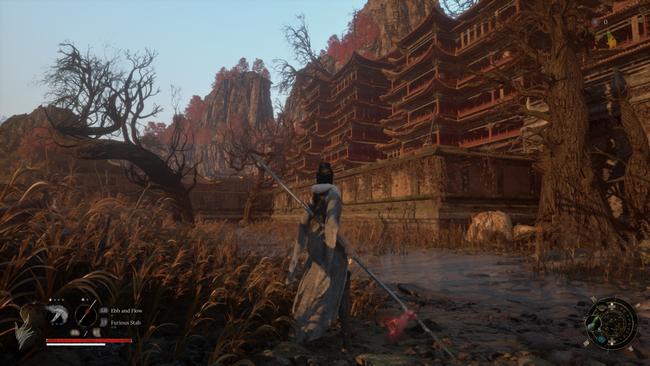
With Wuchang: Fallen Feathers, Leenzee captured a unique premise and atmosphere that I haven’t seen many other games do. It presents a twisted tale surrounding the late Ming Dynasty in which a disease, the Feathering, has rapidly consumed the land. Those affected gradually begin to lose their sanity, their memories, and their humanity. Players take control of a woman named Wuchang, who has recently become infected by the Feathering. She has amnesia, yet her sanity remains.
A fairly significant exchange occurs at the beginning of the game with Xuanyangzi, a Taoist priest. Xuanyangzi reminds Wuchang that she was traveling with someone else, whom she later recalls was her sister, and that he’s been researching how to cure the effects of the Feathering. This cutscene stood out to me because it was the only time that I could recall in which Wuchang herself actively participated in a conversation with her own voice. After this first interaction, she becomes a silent protagonist; players can often choose some dialogue options to get more info about a topic, but Wuchang will say nothing.
I think this works to the game’s detriment, because it sparks an interest in Wuchang’s characterization - yet it immediately fizzles out to her becoming a quiet vessel. Characters will simply share and regurgitate info, with no insight into Wuchang’s perspective as the narrative unfolds. It feels like a lost opportunity.
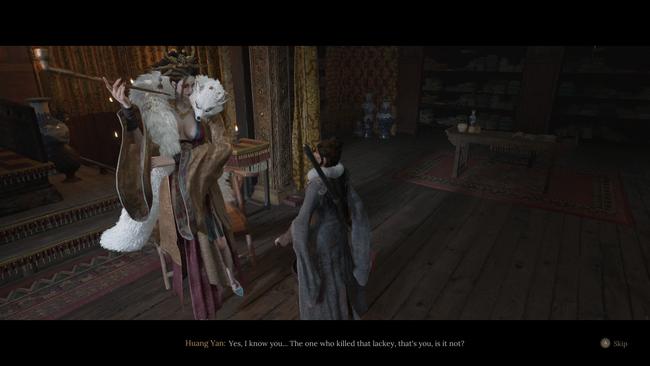
The overall plot itself is serviceable, though I’ll admit that I’ve not brushed up on my Ming dynasty history lessons recently. There are story threads sprinkled throughout the game that can easily be lost on players who have little-to-no understanding of how the Ming dynasty fell, and what political conflicts led to its collapse. Various pre-established factions in Wuchang: Fallen Feathers have already been in conflict, and the spread of the Feathering further fueled the turmoil.
None of it is absolutely vital in piecing together the main plot itself, but many of the details that contextualize several smaller substories will be lost on players. What’s readily apparent is that Leenzee didn’t shy away from painting this era in time under a critical lens. Acts of brutality are commonplace, and many characters in Wuchang are looking to benefit themselves amidst the chaos. Nevertheless, the sentimental nature of many subquests will still evoke a substantial emotional response, if players decide to see them to their full completion.
Despite this, the thing that helps glue Wuchang: Fallen Feathers together is the poisonous mystique of its world design. There’s a beautifully haunting aura that binds the aesthetic of its unique time period with dark fantasy. A room in a palace can be decorated by shiny, lavish ornaments as rotting flesh sprawls throughout its floor, as several cannibals’ sights glaze over the luxurious items in search of their next meal. Meanwhile, a band of rebels huddle together over a small campfire surrounded by the chilling snow as an unholy device nearby keeps on spawning new undead hordes. Wuchang: Fallen Feathers is a merciless world, and it conveys that spectacularly well.
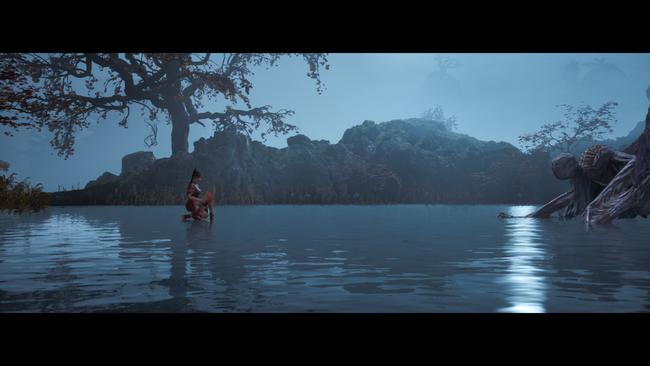
It is rather impressive how well thought-out the level layouts are, especially when considering that this is Leenzee’s debut game. Players will travel from area to area seamlessly, and will occasionally find checkpoint shrines or paths that open up shortcuts back to previously visited shrines. The way that Leenzee has interwoven many of its routes feels smartly tuned.
At first, it seems overwhelming because many of the beginning areas have multiple similar-looking branching paths that present the illusion that it’d be easy to get lost in. As I began to thoroughly explore them, I unknowingly began constructing a mental map of the game world, because they would either loop back to a previous area with a memorable landmark or a new zone that branched into other routes I had previously skipped.
I thought the lack of a map in Wuchang: Fallen Feathers could’ve been one of its downfalls, yet it manages to make that into one of its strengths. It pushed me to painstakingly memorize the route layout for almost every area in the game, which made its environments and locales more memorable organically. Plus, it also helps that the environmental variety begins to substantially ramp up after the first third of the game.
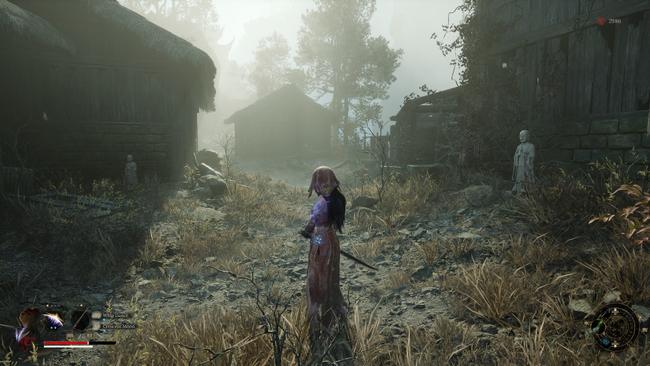
Many environments are just a visual, and sometimes mechanical, treat as well. A snowy region later in the game has an impressive amount of detail placed into what affects the deformation of the snow, for instance. Beyond deforming the snow where Wuchang’s character model has traveled through, it will also deform the snow that is touching the tip of her weapon if it’s large enough to reach it. Opening gates will push snow out of the way of its doors opening, and leave skidmarks. Staying in the snow without consuming the Spicy Soup consumable will gradually fill up the Frostbite ailment that reduces Wuchang’s stamina bar temporarily, but staying in sunlight will reduce the ailment buildup on its own. There are many lovely little details put into the exploration of its world, and this was only a small sample of it.
Another aspect that I commend Leenzee for is Wuchang: Fallen Feathers’ combat system. It starts off a bit unwieldy, but as more weapons, skills, and spells fill Wuchang’s repertoire, the cadence of combat becomes fast, fluid, and most importantly, flexible. As battle encounters become increasingly deadly and difficult, it becomes clear that Wuchang: Fallen Feathers demands a certain level of aggression from players to match the frenetic behavior of their foes.
Players quickly pick up their first one-handed sword, longsword, spear, axe, and dual-blades in the opening hours, and Wuchang can carry up to two weapons at any given time. Each weapon type has its unique basic light attack string, a chargeable heavy attack, and one primary weapon ability that’s unique to that specific weapon itself. For example, a player may carry two spears with them, but each of those spears has different primary weapon abilities inherent to them that cannot be swapped out. Weapons do have a secondary skill that can be swapped out, though, and up to four Spells can be equipped, too. Once people begin to amass numerous amounts of offensive tools, Wuchang: Fallen Feathers can morph into a playbox of different builds and playstyles to experiment with.
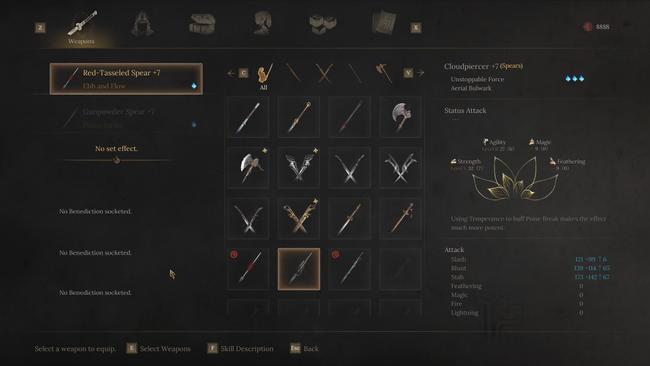
This is possible thanks to the infinite free re-spec option through the game’s skill tree, the Impetus Repository. Instead of spending the souls-currency equivalent to raise each stat point individually, players spend it to gain Red Mercury Essence instead. RME can then be spent to fill in nodes on the skill tree, which is structured more along the lines of how Diablo IV or Path of Exile lays out their skill trees. There are abilities and enhancements that players can make their way towards, and generic stat enhancement nodes make up the path to them.
Every weapon type has its own dedicated branch that begins at the central “core” of the Impetus Repository, while the western branch from that core consists of universal upgrades, such as obtaining different elemental Bone Needles to slot into a refillable Temperance consumable to enchant the equipped weapon with that element for a limited amount of time. Upgrading both the number of health flasks and their potency with special rare items found in grand treasure chests is also in this part of the Impetus Repository.
No matter what build or playstyle a player is going for, the main crux in its battles like in a resource called Skyborn Might. Think of it as a MP like in other RPGs; Skyborn Might allows Wuchang to cast spells and perform enhanced versions of her weapon abilities. Some spells and abilities cost 1 MP, 2 MP, 3 MP, and such. Skyborn Might is primarily gained through perfectly dodging incoming enemy attacks early on, but skill tree enhancements and consumables open up other methods to gain it.
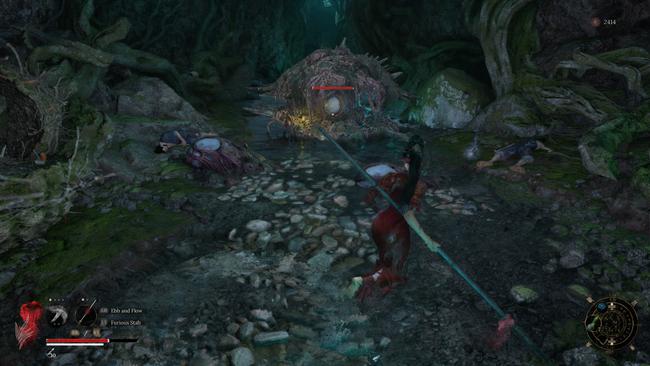
Therefore, this feeds into why enemies maintain a certain level of aggressive behavior. In order to consistently have offensive resources, players have to learn and master proper evasive maneuvers to access the more powerful tools in their arsenal. Blocking and deflecting attacks can be done with a few specific weapon types, so that defensive tool isn’t out of the question - but the main focus is clearly about bobbing and weaving through attacks using the invincibility frames of Wuchang’s dodge.
Another significant mechanic that distinguishes Wuchang: Fallen Feathers from other Soulslikes is its Madness system. A Madness numerical value gradually fills up after each death, though there are consumables and other methods to manually raise it without having to die. Entering the Madness state boosts Wuchang’s damage output, but she also receives more damage in return. Additionally, being above certain Madness value thresholds adds additional properties to her attacks or skills.
A sample case that weaves this all together succinctly is pursuing a magic build with one-handed swords. Spells cost Skyborn Might, so having a reliable supply without consistently dodging enemy attacks is nice to have. One of the first nodes down the one-handed sword branch in the Impetus Repository is that players will occasionally get Skyborn Might just by holding a one-handed sword. Skyborn Might doesn’t last indefinitely, though, so they disappear after a short while when they remain unused. A node later on that one-handed sword tree will ensure that Skyborn Might will no longer decay below 3 stacks, if Wuchang is over 90% Madness. This effectively provides an ample amount of MP to consistently fire off magic spells, as Skyborn Might continually replenishes passively without fearing that it will all disappear once it reaches three stacks.
As I mentioned earlier, players have no need to fear if they want to try a new build or playstyle out with another weapon altogether. Simply resetting the first node that starts a weapon type’s branch in the Impetus Repository will refund all resources that the player has invested in that entire branch - even the valuable items to upgrade Weapon Mastery, which improves a weapon type’s base stats. This can all be done freely, and has unlimited uses. I went through roughly three different builds in my playthrough to get a feel of how other weapons worked.
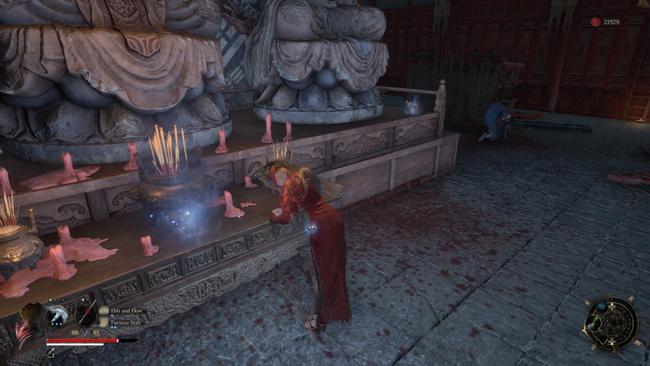
I do feel that the potential of its battle system is only realized in the back half of the game, though. Many of the crazier combat options are held back from the player until much, much further into it. I wish they were more evenly spread out, because the first half of the game is relatively tame in comparison.
Wuchang: Fallen Feathers had some of the most difficult boss fights I’ve fought this year. This game often kicked my ass, and many of those deaths were certainly a skill issue for sure. Still, there were certainly times when I got stuck on a random piece of geometry when I hugged the corners of the boss arena. I eventually learned to never trust being near a wall during boss fights; the boss models themselves occasionally boxed me in, too.
Oddly enough, I appreciated the lack of a central big stagger bar underneath the boss’s HP that would sometimes artificially dictate the intended tempo of a boss fight. There is still a small circular posture bar that fills up, if a player consistently lands hits on a boss, so it doesn’t degrade. Successfully filling that up causes a Poise Break, which leaves the boss staggered for a few seconds that allows players to land a powerful Obliteration attack on it.
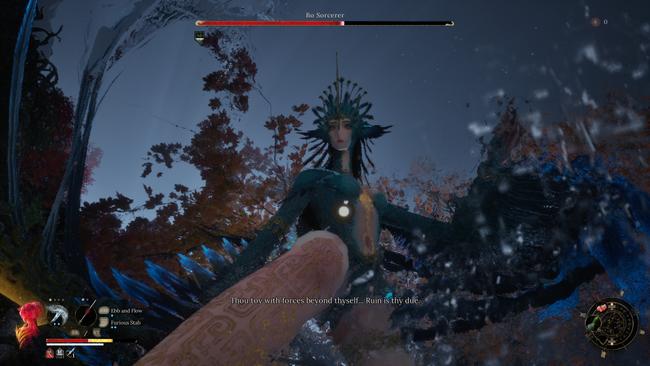
While it certainly helps out during boss fights, the attack cycle of boss encounters doesn’t revolve around this one mechanic alone; players have to make numerous quick, snappy judgment calls on which attacks are punishable, and which ones must be respected at all costs. Depending on a player’s loadout and playstyle, that answer will be different on a case-by-case basis.
People ultimately have to open a path for their own damage phases, instead of waiting for the game to tell them that they can now attack via a more traditional usage of a stagger bar. Bosses are often relentless, and will certainly input read when people press the button to consume a health flask. I’ve seen specific bosses merely wait for that moment, and swiftly attack in my moment of panic.
Ironically enough, the bosses in the first two-thirds of the game were more memorable than the last stretch of them because I struggled with them more overall. I happened to stumble onto a build that really, really shifted the balance of power in my favor, so I defeated what would have been incredibly difficult bosses with relative ease. I’m still a bit baffled by how well this build came together, so I do ponder if Leenzee will tweak it down the line.
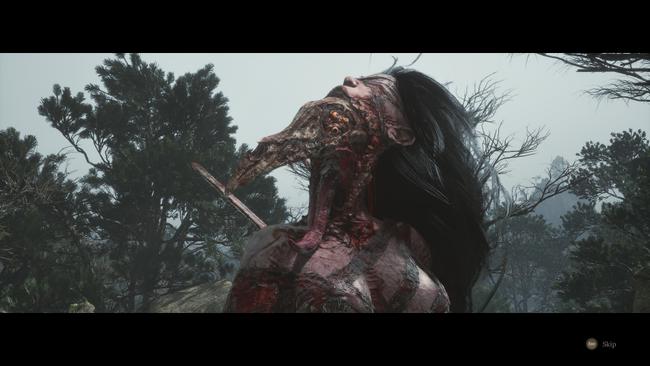
I’d also like to call out the great music in Leenzee’s debut game. The frequent use of traditional Chinese instruments is splendid. Some of the ones that are prominent in Wuchang: Fallen Feathers’ tracks are the pipa, dizi, erhu, and suona; they exude an eloquent symphony that naturally vibes with the intoxicatingly eerie atmosphere that the developers have crafted. It’s a beautiful score that isn’t afraid to switch to another genre immediately to complement a boss’s form transformation.
Prevalent in the lead-up to the release of Wuchang: Fallen Feathers was its marketable fanservice aspect. There are many outfits in the game - whether it’s preorders, the Deluxe Edition, or simply earning it in-game - that are revealing and deliberately sexy. Some fall in line with era-appropriate attire, while others are over-the-top and fantastical. I personally don’t care as long as that aspect doesn’t take away from a solid core gameplay loop, and Wuchang: Fallen Feathers displays that time and time again. Plus, there are many other outfits that show less skin that are still quite dazzling to behold.
While I’d love to say that my time with this game was a great time, Wuchang: Fallen Feathers’ biggest undoing is the abysmal optimization I experienced with its PC version. I have a RTX 3080 GPU and a 5900X CPU, which should be decent enough to run this game smoothly, but frequent stutters and blurry textures to get it running somewhat smoothly dragged the entire game experience down. There were several memory leak issues in the back half of the game, and I even had the game crash since I was out of video memory because my SWAP usage maxed out - so I had to restart my entire PC because of the game. Many other PC players seem to have similar, or worse, experiences that Leenzee is still trying to fix as of the publication of this review.

Wuchang: Fallen Feathers is incredibly impressive when viewed as the first game project developed and released by Leenzee. It’s ambitiously put together when it comes to the marriage of its various flexible gameplay systems and a game world that’s constructed seamlessly. Its depiction of the late Ming dynasty is fascinating because it isn’t afraid to show the brutal circumstances that loomed over this time period, even when separated from all of the dark fantasy elements that provide flavor to it. I enjoyed my time a lot with Wuchang: Fallen Feathers, but its horrid performance and optimization on PC unfortunately damaged my overall enjoyment.